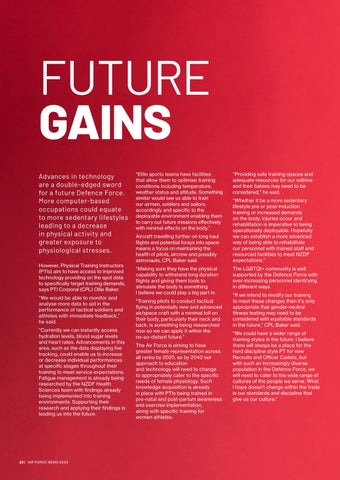FUTURE GAINS Advances in technology are a double-edged sword for a future Defence Force. More computer-based occupations could equate to more sedentary lifestyles leading to a decrease in physical activity and greater exposure to physiological stresses. However, Physical Training Instructors (PTIs) aim to have access to improved technology providing on the spot data to specifically target training demands, says PTI Corporal (CPL) Ollie Baker. “We would be able to monitor and analyse more data to aid in the performance of tactical soldiers and athletes with immediate feedback,” he said. “Currently we can instantly access hydration levels, blood sugar levels and heart rates. Advancements in this area, such as the data displaying live tracking, could enable us to increase or decrease individual performances at specific stages throughout their training to meet service expectations. Fatigue management is already being researched by the NZDF Health Sciences team with findings already being implemented into training environments. Supporting their research and applying their findings is leading us into the future.
22 | AIR FORCE NEWS #243
“Elite sports teams have facilities that allow them to optimise training conditions including temperature, weather status and altitude. Something similar would see us able to train our airmen, soldiers and sailors accordingly and specific to the deployable environment enabling them to carry out future missions effectively with minimal effects on the body.” Aircraft travelling further on long haul flights and potential forays into space means a focus on maintaining the health of pilots, aircrew and possibly astronauts, CPL Baker said. “Making sure they have the physical capability to withstand long duration flights and giving them tools to stimulate the body is something I believe we could play a big part in. “Training pilots to conduct tactical flying in potentially new and advanced air/space craft with a minimal toll on their body, particularly their neck and back, is something being researched now so we can apply it within the no-so-distant future.” The Air Force is aiming to have greater female representation across all ranks by 2025, so by 2042 our approach to education and technology will need to change to appropriately cater to the specific needs of female physiology. Such knowledge acquisition is already in place with PTIs being trained in pre-natal and post-partum awareness and exercise implementation, along with specific training for women athletes.
“Providing safe training spaces and adequate resources for our wāhine and their babies may need to be considered,” he said. “Whether it be a more sedentary lifestyle pre or post-induction training or increased demands on the body, injuries occur and rehabilitation is imperative to being operationally deployable. Hopefully we can establish a more advanced way of being able to rehabilitate our personnel with trained staff and resourced facilities to meet NZDF expectations.” The LGBTQI+ community is well supported by the Defence Force with ever-increasing personnel identifying in different ways. “If we intend to modify our training to meet these changes then it’s only appropriate that gender-neutral fitness testing may need to be considered with equitable standards in the future,” CPL Baker said. “We could have a wider range of training styles in the future. I believe there will always be a place for the hard discipline style PT for new Recruits and Officer Cadets, but with such an increasingly diverse population in the Defence Force, we will need to cater to the wide range of cultures of the people we serve. What I hope doesn’t change within the trade is our standards and discipline that give us our culture.”














